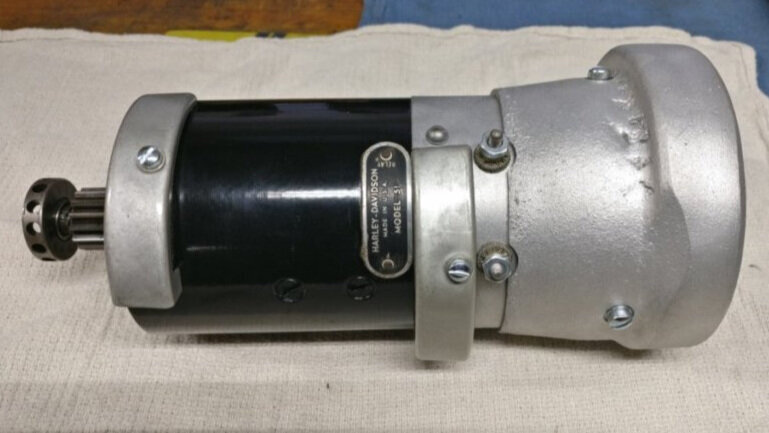H-D Generator Services
Here’s a Model 51 we recently refurbished for a customer with a Servi Car.
I’ve been working with Harley generators for 40+ years. It started out because I just wanted to see at night, and get home when I started out on a ride. I just wanted my electrics to work. My daytime career was in electronics, so my growth in my career paralleled time with Harleys. My first Harley came with a 32E2R radio generator, which I promptly swapped off for a 32E, ‘cause “who wants one of those weird things, I want what everyone else has”.
That’s where it started. I’ve been working with these things ever since. Since I’ve retired from my day job, I’ve started reworking these old Harley generators to support my old bike habit. I’m a small low key operation and want to keep it that way. But I do enjoy working with the old generators and want to pass on my expertise to those in need.
I offer to refurbish a Customer’s genny or can sell one I have previously redone. I try to keep my rates reasonable, I’m not trying to get rich, (nobody who works on old Harley’s is getting rich), just bring in a little extra cash now and again.
Here’s what I offer:
I call it refurbishing, which to me means if it’s an old Harley generator and it has good parts in it I’ll clean them up, treat with insulating varnish, and reuse them.
Typically, an armature will have the commutator cleaned, growled, and tested for shorts and opens. If it’s serviceable, I reuse it.
Fields, if working, get frayed wires treated to shrink tubing, resoldering as required, etc.
The premise is that I’d rather reuse good genuine H-D made parts, than trust to new imported items.
I use new screws, typically Fillister head where original, beadblast aluminum, and sand and paint iron, as part of the treatment. Plus, new sealed bearings and modern lipped oil seal.
If you want your 6 Volt generator upgraded to 12 volt, we do that as well. My solution for 12 volt conversion is to reuse the current 6 volt armature and install 12 fields as are used in the HD 65A generator. No special 12 armature is used or required to make the conversion. This applies to the 32E, 52, 58, 61 series 6 volt gennys as well as the Fan and non Fan radio generators. this approach was shown to me by an old nearby Harley dealer, and has worked well for me for many years.
The brief reasoning is simple. A Harley 6 volt armature uses heavier gauge wires in it windings than a 12 volt armature. The heavier windings heat up less for the same current than a 12 volt armature, which has more windings of smaller gauge.
As anyone who’s run a 32E three brush generator knows, when the ground wire drops off the battery the voltage goes way over 12 volts just before the lights blow! So, the 6 volt armature certainly has the 12 capabilities. And is more resistant to self destruction. The down side is that it takes a few more rpm’s before 12 volts is reached and the system begins charging. Typically, Converted generators begin charging about 1100 rpm’s. Small trade off for much improved reliability.
We also sell a small 12 volt electronic voltage regulator with a lifetime guarantee, return for repair or replacement, no charge. It’s something I’ve developed over the years for my own use, and at this point feel comfortable offering it to the public. $65.00.
Regulator installed on a ‘58 Pan. (the small aluminum box.
Regulator showing red LED ON light, LED’s Red, genny’s working!
Voltage regulator update, 11/2020:
Sold one of my regulators recently to someone who wanted to update a mechanical regulator. He gutted the mechanical case, and installed one of my regulators instead. Did a neat job of it and the electronic unit needed little modification. He moved the cabling and its grommet to the side of the case and pushed in the LED ‘till it was flush with the case. (They’re a press fit with a dab of silicone to seal). Here are the results:
Electronic unit mounted to the old gutted mechanical base.
Here’s the regulator mounted on the customer’s bike. He left the cover off to show off his mounting. The cover just fits very nicely. He put a couple of holes in the bottom side of the old regulator cover to give the electronics a little ventilation. Nice Job!





